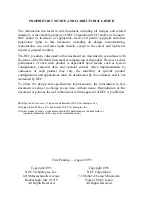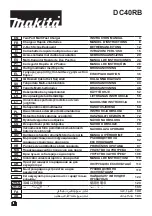
50
•
The charger has two charging channels that are independent of each other, so that up to two recharge-
able batteries/rechargeable battery packs can be charged (or discharged) at once. However, only con-
nect a single rechargeable battery/rechargeable battery pack to each of the two charging channels.
Never connect the charging channels to each other!
•
If the product is not to be used for an extended period of time (e.g. storage), disconnect any connected
rechargeable battery from the charger and disconnect the charger from the voltage/current supply.
The charger has no mains switch. If you operate the charger via the mains cable, pull the mains plug
from the socket when you no longer need the charger.
•
Do not charge/discharge any battery that is still hot (e.g. caused by high discharging current from the
model). Allow the rechargeable battery to cool down to room temperature before attempting to charge
or discharge it.
• Never damage the exterior cover of a battery. There is a risk of fire and explosion!
• Never charge/discharge damaged, leaking or deformed batteries. This can result in a fire or explosion!
Dispose of any unusable rechargeable batteries in an environmentally compatible fashion. Do not con-
tinue to use them.
•
Remove the battery from the charger when it is fully charged.
•
Recharge the rechargeable batteries about every 3 months. Otherwise, so-called deep discharge may
result, rendering the rechargeable batteries useless.
• Keep rechargeable batteries in a suitable location. Use a smoke detector in the room. The risk of fire (or
the occurrence of toxic smoke) cannot be excluded. Special rechargeable batteries for the model con-
struction area are subject to great stress (e.g. high charging and discharging currents, vibrations, etc.).
b) Additional Information about Lithium Batteries
Modern batteries with lithium technology do not only have a clearly higher capacity than NiMH or NiCd
rechargeable battery packs but they also have a considerably lower weight. This makes this type of re-
chargeable battery very interesting for application in model construction; so-called LiPo batteries (lithium-
polymer) are often used here.
Rechargeable lithium batteries require special care when charging/discharging, as well as during operation
and handling.
For this reason, we would like to provide you with some information in the sections below about the dangers
and how you can avoid them, thus helping such batteries to maintain their performance for an extended
period of time to come.
Additionally observe chapter 6. a).
•
The outer shell of many rechargeable lithium batteries is only made of a thick foil and therefore very
sensitive.
Never destroy or damage the battery, never let the battery fall and do not pierce the battery with any
objects! Avoid any mechanical strain on the battery; never pull the connection cables of the battery!
There is a risk of fire and explosion!
These guidelines must also be observed when the battery is inserted into the model or when it is re-
moved from the model.
















































